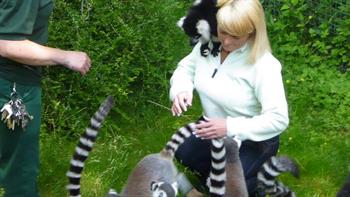 Learn Dog Behaviour
Learn Dog Behaviour
- A foundation course of study to become a dog behaviourist
- Explore how dogs think, following your passion; to better understand how to manage dogs as pets or working animals.
COURSE STRUCTURE and CONTENT
There are 9 lessons in this course:
- Nature and Scope of Canine Psychology
- A brief history of the canine evolution
- Self-domestication
- Canine industries
- Canine Senses
- Understanding canine communication
- Sight
- Body Language
- Smell
- Sound
- Elimination Postures
- Understanding Natural Canine Behaviour
- Social Structure
- Social Behaviour
- Aggression
- Clinical Problems
- Biological Rhythms
- Sleep
- Sexual Behaviour
- Maternal Behaviour
- Parturition
- Suckling and Weaning
- Eating and Drinking
- Canine Behavioural Development
- Nature or Nurture
- Sensitive Periods
- Neurological Development
- Canine Temperament Testing
- How Breeds Differ
 Canine Behavioural Disorders
Canine Behavioural Disorders
- Attention Seeking Behaviour
- Excessive barking
- Chewing
- Running away
- Chasing moving objects
- Begging
- Digging
- Separation anxiety
- Aggression
- Phobias
- Excessive compulsive disorders
- Cognitive Dysfunction
- Calming a dog
- Basic Dog Training
- Forming habits
- Conditioning
- Classical Conditioning
- Operant Conditioning
- Socialisation
- House training
- The use of visual signals
- The use of voice commands
- The use of training aids
- Dog Obedience Training
- Practical Training Techniques
- Recall
- Sit
- Stand
- Drop
- Leave
- Down
- Stay
- Heel
- Seek
- Retrieve
- Bark on Signal
- Controlling a Dogs Movement
- Territorial nature of dogs
- Fencing
- Dog doors
- Kennels
- Exercise requirements
- Socialisation requirements
- Walking on a lead/leash
- Electronic barriers
- Microchips
- Pet Registration and Licensing
 Controlling Killing Wildlife
Controlling Killing Wildlife
- Training Working Dogs
- Training for scent discrimination or substance detection
- Training for retrieving
- Guarding
- Hearing dogs
- Herding
- Tracking
- Controlling attacks on animals and people
Each lesson culminates in an assignment which is submitted to the school, marked by the school's tutors and returned to you with any relevant suggestions, comments, and if necessary, extra reading.
Aims
- Describe how canine animals think and discuss the relevance of understanding canine psychology to people.
- Explain how canine animals communicate and formulate an understanding of possible ways that a human may communicate with a dog.
- Understand behaviours that are natural and predictable in canines and learn to recognise and understand signals that dogs give.
- Explain how dogs develop behavioural characteristics throughout stages of their life.
- Describe commonly occurring behavioural problems in dogs.
- Develop a program for training a new pet dog when it is brought into a household.
- Explain how to train a dog to perform predetermined actions upon command.
- Describe how the movement of dogs can be controlled, both through training and other methods.
- Describe how dogs can be trained to perform tasks required as a working dog, including a sheep dog, tracking dog, blind dog or substance detection dog.
 Canine Industries
Canine Industries
Dogs fill a variety of roles in our current human society. Working dogs can carry out a variety of jobs from herding sheep, helping the lives of disabled and blind people, to seeking out and detecting explosives and drugs.
In most countries around the world, the most common role of domesticated dogs is as a companion animal to humans. There are a wide variety of ancillary industries that rely on this companion animal market.
Some examples include:
- Dog breeding enterprises
- Dog grooming enterprises
- Dog Training enterprises
- Dog Boarding or Kennel enterprises
- Dog Walking and Pet Sitting
- Pet shops sell a range of products and equipment
- Canine Behaviour Therapists
- Complimentary Medicines and Therapies
Walking on a Lead/Leash
 Dogs need to be trained to walk on a lead. In some countries, it is not legal to have a dog without a lead or collar. In others, dogs can walk off the lead, but should behave sensibly and obey owners’ commands. It is imperative that they learn to walk on a lead appropriately. Dogs often do not like walking on a lead at first and training to walk with the lead attached to the collar takes time too.
Dogs need to be trained to walk on a lead. In some countries, it is not legal to have a dog without a lead or collar. In others, dogs can walk off the lead, but should behave sensibly and obey owners’ commands. It is imperative that they learn to walk on a lead appropriately. Dogs often do not like walking on a lead at first and training to walk with the lead attached to the collar takes time too.
Let’s think about, why would dogs be ok with be restrained? It goes against their natural instinct and the sensation of having something restricting around the neck is not particularly nice. When the dog associates the lead with having fun or going for a walk, then they tend to get more used to it and accept it. Many dogs dislike the lead as it prevents their flight instinct. When faced with a situation which frightens the dog, the dogs fight or flight response kicks in (like that in humans). This is an inherent survival mechanism for animals. In a situation where a dog becomes frightened by another dog, it will either want to fight or flight.
The lead restricts the action of flight linked to this natural instinct and therefore quite often we see behaviour changes when the dog is kept on the lead. Not all dogs react this way, however, we can’t deny the facts. A dog on a lead can appear generally more aggressive than any dog off-lead, as the lead has removed that natural ability to run therefore the ‘fight’ response is the only response they have.
Dogs need to learn that there are times they need to be walked or restrained by a lead and such situations are necessary. For example, if the dog is going to the veterinarians or just walking down a busy street or road, then the lead is essential.
WHY DO THIS COURSE?
Everyone has a different reason for studying. You may simply want to better understand your own dog so you can train it, and better manage it, or you may be looking to develop skills that can be used for working with dogs.
 WORKING IN AN ANIMAL SHELTER
WORKING IN AN ANIMAL SHELTER
A knowledge of dog psychology and training can be an excellent foundation for working in an animal shelter. a charity. They may undertake some or all of the following tasks:
- Animal rescue of abandoned, mistreated or injured animals
- Controlling stray or feral animals
- Licensing or registration of domestic animals
- Enforcing laws relating to animals
- Relocation of abandoned animals through adoption programs
- Relocation of wild animals
- Euthanasia and disposal of dead animals
A lot of the work involves dealing with the public This may include people who have mistreated animals, others who are regretfully in a position that requires them to surrender their animals; the general public who report strays or nuisance animals, and people visiting the shelter to register pets.
Part of the work also involves caring for animals (feeding, watering, exercising and grooming), ans part is dealing with administrative tasks behind a computer or desk.
Opportunities:
In the USA there are more than 2,000 animal shelters. Most major cities in Australia, the UK and other developed countries will operate animal shelters. Organisations such as the RSPCA (Royal Society for the Prevention of Cruelty to Animals) also operate animal shelters.
Many animal shelters employ paid staff, but also welcome assistance from volunteers. Often volunteering can be a good way to get experience, and improve your opportunity to eventually get paid work.
A small shelter in a small rural municipality might only have one employee (eg. The local Dog Catcher), who does everything at the pound or shelter; but larger shelters can employ many staff and volunteers, starting with low level jobs such as kennel worker or clerk. Often these lower level jobs lead to promotion to better paid and more involved positions such as an Animal Services Officer or Animal Complaints Investigator, which involves responding to complaints and when necessary, retrieving animals and bringing them back to the shelter.
Other jobs can involve:
- Management -Medium size shelters may employ a single CEO to oversee the entire operation; but larger shelters may employ an Executive Manager, as well as other managers such as a Director of Animal Services and an Administration manager.
- Health Services –larger shelters may employ a veterinary nurse or veterinarian to attend to the health and welfare of animals in its care
- Education services - Visiting schools and community groups, educating people about animal welfare).
Some shelters will specialise in dealing with certain types of animals; such as a marine animal rescue service that may deal primarily with marine animals.
Risks and challenges:
 Many people have built very successful long term careers working in animal shelters; however, this is an industry sector that depends upon outside funding, usually from either government budget allocations or donations from the public and benefactors. Whenever animal care is high in the public consciousness, funding is good and career prospects strong; but there is always a risk of career opportunities decline, if and whenever the public interest in animal welfare declines.
Many people have built very successful long term careers working in animal shelters; however, this is an industry sector that depends upon outside funding, usually from either government budget allocations or donations from the public and benefactors. Whenever animal care is high in the public consciousness, funding is good and career prospects strong; but there is always a risk of career opportunities decline, if and whenever the public interest in animal welfare declines.
There are also obvious risk involved in dealing with (possibly wild) animals:
- Some jobs require you to deal with hazardous materials (e.g. toxic chemicals, animal faeces).
- Whilst handling animals there is a risk of being bitten or the transfer of parasites and disease.
You may also be exposed to traumatised and severely injured animals which can be upsetting.
As well as dealing with animals, you may also be required to deal with the people who have abused or mistreated their animals which can be risky and challenging.
How to become an Animal Shelter Staff :
People find their way into this time of work by a large variety of paths. People tend to think the obvious way to enter a career in animal welfare is by undertaking a veterinary science qualification. This may be one pathway, but it is not necessarily the most common pathway.
A knowledge of animal care and behaviour is a big advantage; but equally important is an ability to communicate with people and an appropriate attitude. Animal shelter workers need to have a real concern for animal welfare, but an ability to deal with upsetting situations that will almost certainly keep arising at work. If you cannot cope with seeing abused animals or needing to euthanize animals in a pragmatic but still caring way; you are probably not suited to this type of job.
Other related jobs might include:
- Pet shop staff
- Dog Trainer or Behaviourist
- Veterinarian
- Vet assistant
- Groomer
- Breeder